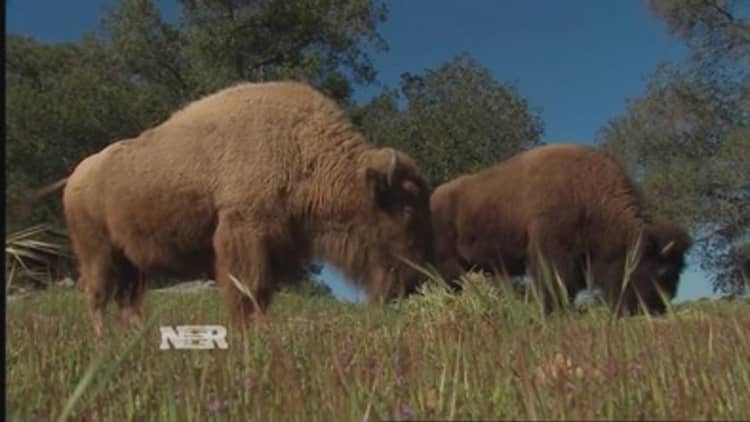Bison is America's original protein, and now it's America's hottest. Buffalo meat puts the "paleo" in the popular Paleo Diet.

Sales of bison meat continue to grow, and so does the national herd. Consumers with more disposable income are attracted to grass-fed bison's low fat content, buying it everywhere from local farmer's markets to Whole Foods.
"Ground bison sells at a retail level anywhere from $12 to $14 a pound," said Ken Childs, who's raised bison on his Star B Buffalo Ranch east of San Diego for 37 years. "A bison filet steak is probably some of the best steak you're going to have. It's selling upwards for about $35 a pound at a retail store."
Read More Want muscles? Rice is the new meat
At a wholesale level, the National Bison Association reports prices have grown from $1.60 a pound in 2004 to nearly $4 a pound last year.
Childs could sell more meat—if he had it. But rather than increase his herd, he's reducing it. He's run into a roadblock that's tougher than a herd of running buffalo: .
"We depend on the rainfall for our grass to grow, and if we don't get that grass, that means we've simply got to cut back on how many animals that we can keep on the property," he said.
Making his situation tougher is that many slaughterhouses are not equipped to handle bison, which are still classified as wild game by the USDA. Even though the industry is growing, it's still a small market with no futures contracts as hedging tools. The total number of bison processed last year—estimated at 67,000—equals only one half of one day's worth of processed beef cattle. "I can't just run down to the local livestock sale," Childs said, "and sell my animals to shrink the size of my herd."
Read MoreOutside states to California dairy farmers: We have water
To keep the herd going, Childs has been supplementing the animals' grass diet with alfalfa. But it's not cheap.
"We pay horribly high prices for alfalfa," he said. There is local alfalfa being grown, even in the drought, but Childs said a lot of it is being exported for better prices to places like Japan. "It's easy to get to the ports where it can be shipped off, and there's quite a bit growing in this region."
The USDA recently agreed to its first purchase of bison meat for the federal school lunch program, and the National Bison Association predicts total sales this year will top $300 million, up from $280 million a year ago. The association attributes growth to a combination of more bison and higher prices.
Until the rains come to California, Ken Childs can only watch from the sidelines as the bull market in bison continues its run. "I'd love to have some more animals here," he said.


